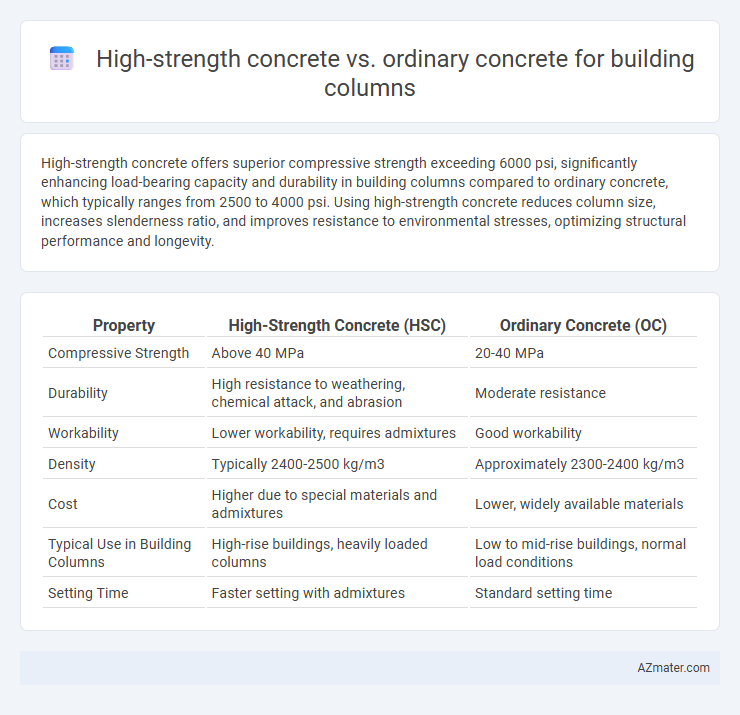High-strength concrete offers superior compressive strength exceeding 6000 psi, significantly enhancing load-bearing capacity and durability in building columns compared to ordinary concrete, which typically ranges from 2500 to 4000 psi. Using high-strength concrete reduces column size, increases slenderness ratio, and improves resistance to environmental stresses, optimizing structural performance and longevity.
Table of Comparison
| Property | High-Strength Concrete (HSC) | Ordinary Concrete (OC) |
|---|---|---|
| Compressive Strength | Above 40 MPa | 20-40 MPa |
| Durability | High resistance to weathering, chemical attack, and abrasion | Moderate resistance |
| Workability | Lower workability, requires admixtures | Good workability |
| Density | Typically 2400-2500 kg/m3 | Approximately 2300-2400 kg/m3 |
| Cost | Higher due to special materials and admixtures | Lower, widely available materials |
| Typical Use in Building Columns | High-rise buildings, heavily loaded columns | Low to mid-rise buildings, normal load conditions |
| Setting Time | Faster setting with admixtures | Standard setting time |
Introduction to Concrete Types in Building Columns
High-strength concrete exhibits compressive strengths exceeding 6,000 psi, significantly outperforming ordinary concrete typically rated between 3,000 to 4,000 psi, making it ideal for building columns requiring enhanced load-bearing capacity and durability. This advanced concrete type incorporates low water-cement ratios and supplementary cementitious materials such as silica fume or fly ash to achieve superior strength and reduced permeability. Ordinary concrete, while cost-effective and widely used, provides adequate performance in standard load conditions but may lack the resilience needed for high-rise or heavily loaded structural columns.
Defining High-Strength Concrete and Ordinary Concrete
High-strength concrete is defined by its compressive strength exceeding 6,000 psi (41 MPa), achieved through optimized mix design that includes low water-cement ratios, advanced admixtures, and superior quality aggregates. Ordinary concrete typically exhibits compressive strength between 2,500 and 4,000 psi (17 to 28 MPa), with a standard mix design suitable for general construction purposes. The enhanced properties of high-strength concrete make it ideal for building columns requiring greater load-bearing capacity and durability.
Composition Differences: High-Strength vs Ordinary Concrete
High-strength concrete for building columns contains a lower water-to-cement ratio, often below 0.35, compared to ordinary concrete which typically ranges from 0.45 to 0.60, resulting in enhanced density and compressive strength above 50 MPa. The mixture includes supplementary cementitious materials like silica fume or fly ash to improve durability and bonding, whereas ordinary concrete relies mainly on Portland cement with standard aggregates. High-strength concrete also uses finer aggregates and chemical admixtures such as superplasticizers to promote workability without increasing water content, differentiating its composition significantly from ordinary concrete.
Structural Performance and Load-Bearing Capacity
High-strength concrete (HSC) significantly enhances the structural performance and load-bearing capacity of building columns compared to ordinary concrete (OC). HSC exhibits superior compressive strength typically above 50 MPa, resulting in reduced column cross-sections while supporting higher loads, improving overall structural efficiency. Its dense microstructure also offers improved durability and resistance to cracking, which extends the service life under heavy load conditions.
Durability and Longevity: Comparative Analysis
High-strength concrete exhibits superior durability compared to ordinary concrete due to its lower permeability and enhanced resistance to environmental factors such as freeze-thaw cycles, chemical attacks, and abrasion. This increased durability substantially improves the longevity of building columns by reducing maintenance needs and extending the service life of the structure. Research indicates that high-strength concrete columns retain structural integrity under aggressive conditions significantly longer than those constructed with ordinary concrete, making them ideal for high-load and harsh environment applications.
Workability and Placement Challenges
High-strength concrete (HSC) exhibits lower workability compared to ordinary concrete due to its reduced water-cement ratio and denser mix composition, which can lead to difficulties in flow and compaction during column placement. The increased viscosity and stickiness of HSC often necessitate advanced admixtures and vibration techniques to ensure proper consolidation without segregation or honeycombing. Ordinary concrete offers easier handling and placement in building columns but lacks the durability and load-bearing capacity provided by high-strength concrete, making the latter more suitable for structures subjected to high stress despite the challenges in workability.
Cost Implications and Material Efficiency
High-strength concrete (HSC) offers superior compressive strength compared to ordinary concrete, allowing for slimmer column designs and reduced material usage, which enhances overall construction efficiency. Despite higher initial costs due to specialized cement, additives, and quality control, HSC's long-term benefits include lower labor and formwork expenses and reduced transportation costs. Conversely, ordinary concrete involves lower upfront costs but may require larger cross-sections and reinforcement, potentially increasing material consumption and structural weight.
Sustainability and Environmental Impact
High-strength concrete significantly reduces the volume of material required for building columns, leading to lower resource consumption and decreased carbon emissions compared to ordinary concrete. Its enhanced durability extends the lifespan of structures, minimizing the need for frequent repairs and reconstruction, thereby reducing environmental waste. Utilizing high-strength concrete supports sustainable construction by improving energy efficiency and promoting the use of recycled materials in the mix.
Code Requirements and Industry Standards
High-strength concrete (HSC) for building columns must comply with ASTM C39 and ACI 318 standards, requiring a minimum compressive strength above 6000 psi, while ordinary concrete typically ranges from 3000 to 5000 psi under the same codes. Design specifications mandate stricter curvature, load-bearing capacity, and durability criteria for HSC columns, ensuring enhanced performance under seismic and axial loads as per Eurocode 2 and IS 456 guidelines. Industry standards emphasize concrete mix design, curing practices, and quality control tests like slump, compressive strength, and modulus of elasticity to differentiate HSC from ordinary concrete in structural applications.
Selecting the Right Concrete for Building Columns
High-strength concrete offers superior compressive strength, often exceeding 6000 psi, making it ideal for building columns subjected to heavy loads and high stress. Ordinary concrete, with typical strengths around 3000-4000 psi, is suitable for standard construction where load demands are moderate. Selecting the right concrete depends on structural requirements, load-bearing capacity, durability needs, and project budget to ensure safety and longevity of building columns.

Infographic: High-strength concrete vs Ordinary concrete for Building column
 azmater.com
azmater.com